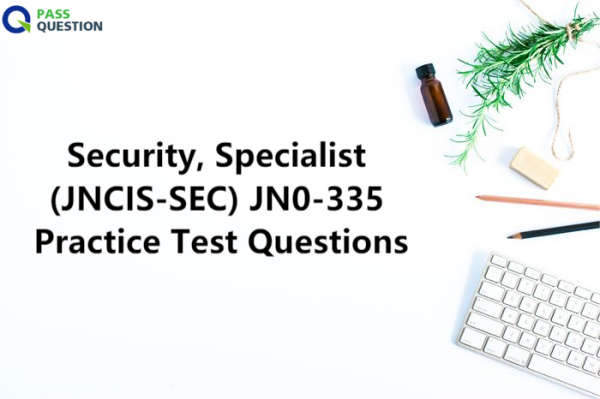Security, Specialist (JNCIS-SEC) JN0-335 Practice Test Questions
Get Ready to Boost Your Juniper Networks Security Skills by passing Security, Specialist (JNCIS-SEC) exam. PassQuestion newly released Security, Specialist (JNCIS-SEC) JN0-335 Practice Test Questions which allows you to identify your strengths and weaknesses, allowing you to focus your study efforts and improve your chances of success on the JN0-335 exam. By using the Security, Specialist (JNCIS-SEC) JN0-335 Practice Test Questions, you can enhance your skills and increase your chances of passing the real exam. The Security, Specialist (JNCIS-SEC) JN0-335 Practice Test Questions are an efficient and convenient way to prepare for the JNCIS-SEC certification. It provides you with the knowledge and hands-on experience necessary to pass the JN0-335 exam and advance your career in the Juniper Networks security field.

JN0-335 Exam Overview - Security, Specialist (JNCIS-SEC)
The Security track enables you to demonstrate a thorough understanding of security technology in general and Junos OS software for SRX Series devices. JNCIS-SEC, the specialist-level certification in this track, is designed for networking professionals with intermediate knowledge of the Juniper Networks Junos OS for SRX Series devices. The written exam verifies your understanding of security technologies and related platform configuration and troubleshooting skills.
Security, Specialist (JNCIS-SEC) JN0-335 Exam Information
- Exam Code: JN0-335
- Prerequisite Certification: JNCIA-SEC
- Delivered by: Pearson VUE
- Exam Length: 90 minutes
- Exam Type: 65 multiple-choice questions
- Software Versions: Junos OS 22.3
Juniper JNCIS-SEC Certification JN0-335 Exam Topics
- Application Security
- Security Policies (Advanced)
- Advanced Threat Prevension (ATP)
- High Availability (HA) Clustering
- Juniper Networks vSRX Virtual Firewall or cSRX Container Firewall
- Juniper Identity Management Service (JIMS)
- SSL Proxy
- Juniper Networks JSA Series Secure Analytics Portfolio
View Online Security, Specialist (JNCIS-SEC) JN0-335 Free Questions
1. You are deploying a vSRX into a vSphere environment which applies the configuration from a bootable ISO file containing the juniper.conf file. After the vSRX boots and has the configuration applied, you make additional device specific configuration changes, commit, and reboot the device. Once the device finishes rebooting, you notice the specific changes you made are missing but the original configuration is applied.
In this scenario, what is the problem?
A. Configuration changes do not persist after reboots on vSRX.
B. The juniper.conf file was not applied to the vSRX.
C. The configuration file is corrupt.
D. The ISO file is still mounted on the vSRX.
Answer: D
2. Which two functions are performed by Juniper Identity Management Service (JIMS)? (Choose two.)
A. JIMS synchronizes Active Directory authentication information between a primary and secondary JIMS server.
B. JIMS forwards Active Directory authentication information to SRX Series client devices.
C. JIMS collects and maintains a database of authentication information from Active Directory domains.
D. JIMS replicates Active Directory authentication information to non-trusted Active Directory domain controllers.
Answer: A,C
3. Which two statements are true about virtualized SRX Series devices? (Choose two.)
A. vSRX cannot be deployed in transparent mode.
B. cSRX can be deployed in routed mode.
C. cSRX cannot be deployed in routed mode.
D. vSRX can be deployed in transparent mode.
Answer: B,D
4. Which two statements about JIMS high availability are true? (Choose two.)
A. JIMS supports high availability through the installation of the primary and secondary JIMS servers.
B. SRX clients are configured with the shared virtual IP (VIP) address of the JIMS server.
C. SRX clients are configured with the unique IP addresses of the primary and secondary
JIMS servers.
D. SRX clients synchronize authentication tables with both the primary and secondary JIMS servers.
Answer: A,C
5. Which two statements are correct about server-protection SSP proxy? (Choose two.)
A. The server-protection SSL proxy intercepts the server certificate.
B. The server-protection SSL proxy is also known as SSL reverse proxy.
C. The server-protection SSL proxy forwards the server certificate after modification.
D. The server-protection SSL proxy acts as the server from the client’s perspective.
Answer: B,D
6. Which statement is true about high availability (HA) chassis clusters for the SRX Series device?
A. Cluster nodes require an upgrade to HA compliant Routing Engines.
B. Cluster nodes must be connected through a Layer 2 switch.
C. There can be active/passive or active/active clusters.
D. HA clusters must use NAT to prevent overlapping subnets between the nodes.
Answer: C
- TOP 50 Exam Questions
-
Exam
All copyrights reserved 2025 PassQuestion NETWORK CO.,LIMITED. All Rights Reserved.

